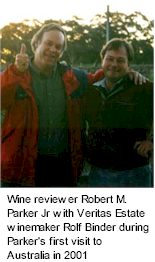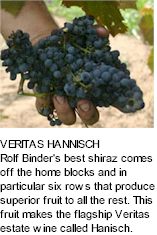


Rolf's story begins in 1950 when his parents arrived from Austria and Hungary, part of the large influx of post war immigration to Australia. They worked with the Victorian railways for three years. During that time they met Elmore Schulz a train driver and a grape grower in the Barossa Valley. In 1953 they picked grapes in the Barossa, met Chris Vohrer and Wilhem Abel and in 1954 worked a vintage in their winery. This is the old winery on Langmeil Road, which they purchased in 1955.

The demand at this time was for fortified wines but slowly a market increased for red table wines from immigrants working at the new industries in Whyalla, Port Pirie and Port Augusta. Highlights include the first of the Bulls Blood which was made in 1967 and was called 'Bikaver'. Later came the realization of the great riches of the Barossa Valley in old vine shiraz, mataro and grenache. Experiments at Veritas and a number of other, mostly small Barossa wineries followed and led through the 1980's to the release of many exciting old vine varietal blends.
Veritas slowly gained recognition and in 1996 and 1997 was awarded the Trophy for Best Small Producer at the Barossa Wine Show and the Trophy for the Best Barossa Shiraz. In 2002 Veritas again won the Trophy for the Best Small Producer. More recently Veritas has been awarded twice in 2002 and 2003 the Trophy for the Best Semillon at the Barossa Wine Show. In 2002 Veritas were the makers of the top three pointed semillons at the Barossa Show and included the gold medal and trophy winning wine.
"2003 Rolf Binder Wines Grenache / Mourvedre / Shiraz Heinrich. From one of Australia’s finest winemakers, this wine stood out brilliantly for its precision, richness, complexity, and ageworthiness. In addition, some very good bargains are available from this talented producer!" -Robert Parker, "The change of name from Veritas to Rolf Binder came with the 50th anniversary of the winery, established by Rolf's and sister Christa Deans' parents. The growth in production and sales is due to the quality of the wines rather than the (hitherto) rather laid-back approach to marketing!" -James Halliday

Wine merchant Noel Young is based in Cambridge U.K. and holds a real passion for the Rhone varieties that matched Rolf's own. Most of the Magpie Estate's production are released into the English market with smaller parcels kept for Australia. The grapes used for Magpie wines are from spme of the better vineyards in South Australia as well as the estate's own. Noel likes more new oak than you would find in Rolf Binder's estate grown Veritas wines, and he takes the trip to Australia twice per year so that he and Rolf together can taste the various parcels of wine and agree on final blends for bottling.
The Magpie expression changes from label to label and this is done to poke fun at wine pretension. The range can vary from vintage to vintage and the following wines have been made over the last few years.
